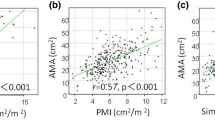Abstract
Background
To propose an ultrasound-based parameter for the diagnosis of muscle mass loss (MML) in cirrhosis.
Methods
This is an IRB-approved cross-sectional study (October 2013 to January 2017) with written informed consent including 357 subjects—234 cirrhosis and 123 controls. MML was diagnosed using the skeletal muscle index at the L3 level (L3-SMI) on computed tomography (CT). Transcutaneous ultrasound was used to demonstrate a cross section of the right iliopsoas muscle, and the iliopsoas muscle index (IP index) was defined by the iliopsoas muscle area/height2 (mm2/m2). Receiver operating characteristic (ROC) curve analysis was performed to assess the diagnostic ability of IP index for MML.
Results
The iliopsoas muscle was detected in all subjects. The IP index was lower in cirrhosis than in controls: males (211.2 ± 73.8 vs. 295.5 ± 139.4, P < 0.0001) and females (200.2 ± 72.5 vs. 284.4 ± 112.4, P < 0.0001). L3-SMI and IP index showed correlations in males (r = 0.699, P < 0.0001) and in females (r = 0.707, P < 0.0001). Independent factors for MML by multivariate analysis were body mass index and IP index in both males and females. Sensitivity, specificity, and area under the ROC curve by IP index to detect MML were 79.5%, 73.1%, and 0.835, respectively, with the best cut-off value of 189.2 for males, and 84.6%, 78.8%, and 0.874, respectively, with the best cut-off value of 180.6 for females.
Conclusions
Using transcutaneous ultrasound, the IP index may be a valuable diagnostic parameter for MML in cirrhosis.




Similar content being viewed by others
References
Tsochatzis EA, Bosch J, Burroughs AK. Liver cirrhosis. Lancet. 2014;383:1749–61.
Durand F, Valla D. Assessment of prognosis of cirrhosis. Semin Liver Dis. 2008;28:110–22.
Cardenas A, Gines P. Management of patients with cirrhosis awaiting liver transplantation. Gut. 2011;60:412–21.
Montano-Loza AJ, Meza-Junco J, Prado CM, et al. Muscle wasting is associated with mortality in patients with cirrhosis. Clin Gastroenterol Hepatol. 2012;10:166–73.
Periyalwar P, Dasarathy S. Malnutrition in cirrhosis: contribution and consequences of sarcopenia on metabolic and clinical responses. Clin Liver Dis. 2012;16:95–131.
Baumgartner RN, Koehler KM, Gallagher D, et al. Epidemiology of sarcopenia among the elderly in New Mexico. Am J Epidemiol. 1998;147:755–63.
Tandon P, Ney M, Irwin I, et al. Severe muscle depletion in patients on the liver transplant wait list: its prevalence and independent prognostic value. Liver Transplant. 2012;18:1209–16.
Englesbe MJ, Patel SP, He K, et al. Sarcopenia and mortality after liver transplantation. J Am Coll Surg. 2010;211:271–8.
Meza-Junco J, Montano-Loza AJ, Baracos VE, et al. Sarcopenia as a prognostic index of nutritional status in concurrent cirrhosis and hepatocellular carcinoma. J Clin Gastroenterol. 2013;47:861–70.
Kaido T, Ogawa K, Fujimoto Y, et al. Impact of sarcopenia on survival in patients undergoing living donor liver transplantation. Am J Transplant. 2013;13:1549–56.
Mitsiopoulos N, Baumgartner RN, Heymsfield SB, et al. Cadaver validation of skeletal muscle measurement by magnetic resonance imaging and computerized tomography. J Appl Physiol. 1998;85:115–22.
Durand F, Buyse S, Francoz C, et al. Prognostic value of muscle atrophy in cirrhosis using psoas muscle thickness on computed tomography. J Hepatol. 2014;60:1151–7.
Sergi G, Trevisan C, Veronese N, et al. Imaging of sarcopenia. Eur J Radiol. 2016;85:1519–24.
Bruix J, Sherman M. Management of hepatocellular carcinoma: an update. Hepatology. 2011;53:1020–2.
Oberti F, Valsesia E, Pilette C, et al. Noninvasive diagnosis of hepatic fibrosis or cirrhosis. Gastroenterology. 1997;113:1609–16.
Colli A, Fraquelli M, Andreoletti M, et al. Severe liver fibrosis or cirrhosis: accuracy of US for detection—analysis of 300 cases. Radiology. 2003;227:89–94.
Mazzaferro V, Regalia E, Doci R, et al. Liver transplantation for the treatment of small hepatocellular carcinomas in patients with cirrhosis. N Engl J Med. 1996;334:693–9.
Nishikawa H, Shiraki M, Hiramatsu A, et al. Japan Society of Hepatology guidelines for sarcopenia in liver disease (1st edition): recommendation from the working group for creation of sarcopenia assessment criteria. Hepatol Res. 2016;46:951–63.
Kondo T, Maruyama H, Sekimoto T, et al. Impact of portal hemodynamics on Doppler ultrasonography for predicting decompensation and long-term outcomes in patients with cirrhosis. Scand J Gastroenterol. 2016;51:236–44.
Masuda T, Shirabe K, Ikegami T, et al. Sarcopenia is a prognostic factor in living donor liver transplantation. Liver Transplant. 2014;20:401–7.
Hamaguchi Y, Kaido T, Okumura S, et al. Impact of quality as well as quantity of skeletal muscle on outcomes after liver transplantation. Liver Transplant. 2014;20:1413–9.
Hanai T, Shiraki M, Nishimura K, et al. Sarcopenia impairs prognosis of patients with liver cirrhosis. Nutrition. 2015;31:193–9.
Prado CM, Lieffers JR, McCargar LJ, et al. Prevalence and clinical implications of sarcopenic obesity in patients with solid tumours of the respiratory and gastrointestinal tracts: a population-based study. Lancet Oncol. 2008;9:629–35.
Cardinot TM, Aragao AH, Babinski MA, et al. Rare variation in course and affluence of internal iliac vein due to its anatomical and surgical significance. Surg Radiol Anat. 2006;28:422–5.
Kose MF, Turan T, Karasu Y, et al. Anomalies of major retroperitoneal vascular structure. Int J Gynecol Cancer. 2011;21:1312–9.
Arts IM, Pillen S, Overeem S, et al. Rise and fall of skeletal muscle size over the entire life span. J Am Geriatr Soc. 2007;55:1150–2.
Arts IM, Pillen S, Schelhaas HJ, et al. Normal values for quantitative muscle ultrasonography in adults. Muscle Nerve. 2010;41:32–41.
Fukumoto Y, Ikezoe T, Yamada Y, et al. Age-related ultrasound changes in muscle quantity and quality in women. Ultrasound Med Biol. 2015;41:3013–7.
Tandon P, Low G, Mourtzakis M, et al. A model to identify sarcopenia in patients with cirrhosis. Clin Gastroenterol Hepatol. 2016;14:1473–80.
Author information
Authors and Affiliations
Corresponding author
Ethics declarations
Conflict of interest
The authors have no conflicts of interest and have not received any financial support for this work.
Rights and permissions
About this article
Cite this article
Kobayashi, K., Maruyama, H., Kiyono, S. et al. Application of transcutaneous ultrasonography for the diagnosis of muscle mass loss in patients with liver cirrhosis. J Gastroenterol 53, 652–659 (2018). https://doi.org/10.1007/s00535-017-1378-2
Received:
Accepted:
Published:
Issue Date:
DOI: https://doi.org/10.1007/s00535-017-1378-2




